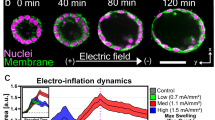Abstract
The central biochemical mechanisms involved in primate parturition are still unclear. Studies in both humans and nonhuman primates such as the baboon and rhesus monkey indicate that many factors play a part in the cascade of interactive positive feedforward loops that progressively promote parturition: changes in maternal endocrinology, a nocturnal switch in myometrial activity from low amplitude, infrequent contractures to high amplitude, high frequency contractions (see Fig. 1), dilation of the cervix and biochemical changes in the fetal membranes that lead to rupture1. Here we demonstrate that infusion of the aromatase inhibitor 4-hydroxyandrostenedione (40HA) inhibits conversion of androgen to estrogen and prevents premature delivery caused by administration of androgen to pregnant rhesus monkeys at 0.8 of pregnancy term. 4OHA also inhibited the androstenedione induced maternal endocrine and fetal membrane biochemical changes, and alteration of myometrial activity patterns. Secondly, peripheral estrogen infusions increased myometrial activity but did not produce preterm delivery or fetal membrane changes. We conclude that paracrine functions of estrogen at its site of production play critical and central roles in delivery in the non-human primate.
This is a preview of subscription content, access via your institution
Access options
Subscribe to this journal
Receive 12 print issues and online access
$209.00 per year
only $17.42 per issue
Buy this article
- Purchase on Springer Link
- Instant access to full article PDF
Prices may be subject to local taxes which are calculated during checkout
Similar content being viewed by others
References
Olson, D.M., Mijovic, J.E. & Sadowsky, D.W. Control of human parturition. Semin. Perinatal. 19, 52–63 (1995).
Magyar, D.M. et al. Time-trend analysis of plasma cortisol concentrations in the fetal sheep in relation to parturition. Endocrinology 107, 155–159 (1980).
Steele, P.W., Flint, A.P.F. & Turnbull, A.C. Activity of steroid C-17,20 lyase in the ovine placenta: effect of exposure to foetal glucocorticoid. J. Endocrinol. 69, 239–246 (1976).
Nathanielsz, P.W. et al. Time trend analysis of plasma unconjugated and sulfocon-jugated estrone and 3β–Δ5 - steroids in fetal and maternal sheep plasma in relation to spontaneous parturition at term. Endocrinology 110, 1402–1407 (1982).
Challis, J.R.G. Sharp increase in free circulating oestrogens immediately before parturition in sheep. Nature 229, 208 (1971).
Eisner, C.W. et al. Time-trend analysis of plasma C-21 steroids in fetal and maternal sheep during the last 18 days of gestation. Endocrinology 107, 801–808 (1980).
Novy, M.J. & Walsh, S.W. Regulation of fetoplacental steroidogenesis in rhesus macaques. In Fetal Endocrinology (Novy M.J. and Resko, J.A., eds), 66-94 (Academic Press, NY, (1981).
Wilson, L., Parsons, M.T. & Flouret, C. Forward shift in the initiation of the nocturnal estradiol surge in the pregnant baboon: Is this the genesis of labor?. Am. I. Obstet. Cynecol. 165, 1487–1498 (1991).
Buster, J.E. et al. Interrelationships of circulating maternal steroid concentrations in third trimester pregnancies. I. C21 steroids: Progesterone, 16α-hydroxyproges-terone, 17α-hydroxyprogesterone, 20α-dihydroprogesterone, Δ5-pregnenolone, Δ5-pregnenolone sulfate, and 17-hydroxy Δ5-pregnenolone. J. Clin. Endo. Metab. 48, 133–138 (1979).
Siiteri, P.K. & Seron-Ferre, M. Some new thoughts on the fetoplacental unit and parturition in primates. In Fetal Endocrinology. (Novy, M.J. and Resko, J.A, eds.), 1-34 (Academic Press, NY, 1981).
Buster, J.E. et al. Interrelationships of circulating maternal steroid concentrations in third trimester pregnancies II. C18 and C19 steroids: estradiol, estriol, dehydroepiandrosterone, dehydroepiandrosterone sulfate, 5-androstenediol, 4-an-drostenedione, testosterone, and dihydrotestosterone. J. Clin. Endo. Metab. 48, 139–142 (1979).
Lye, S.J., Nicholson, B.J., Mascarenhas, M., MacKenzie, L. & Petrocelli, T. Increased expression of connexin-43 in the rat myometrium during labor is associated with an increase in the plasma estrogen: Progesterone ratio. Endocrinology 132, 2380–2386 (1993).
Amico, J.A., Janosky, J.E. & Cameron, J.L. Effect of estradiol and progesterone administration upon the circadian rhythm of oxytocin in the cerebrospinal fluid of rhesus monkeys. Neuroendocrinology 51, 543–551 (1990).
Zhang, P.G., Weston & Hixon, J.E. Influence of estradiol on the secretion of oxytocin and prostaglandin F2α2 during luteolysis in the ewes. Biol. Reprod. 45, 395–403 (1991).
Petrocelli, T. & Lye, S.J. Regulation of transcripts encoding the myometrial gap junction protein, connexin-43, by estrogen and progesterone. Endocrinology 133, 284–290(1993).
Wu, W.X., Owiny, J.R., Zhang, Q., Ma, X.H. & Nathanielsz, P.W. Regulation of the estrogen receptor and its mRNA in the ovariectomized sheep myometrium and en-dometrium: The role of estradiol and progesterone. Biol. Reprod. 555, 762–768 (1996).
J.,Daren, McGarrigl, C.L. & Lachelin,, G.C.L Increased saliva oestriol to progesterone ratio before idiopathic preterm delivery: a possible predictor for preterm labour. Br. Med. J. 294, 270–272 (1987).
Germain, A.M., Kato, S., Villarroel, L.A., Valenzuela, G.J. & Seron-Ferre, M. Human term and preterm delivery is preceded by a rise in maternal plasma 17-estradiol. Prenatal & Neonatal Med. 1, 57–63 (1996).
Haluska, G.J., Cook, M.J. & Novy, M.J. Inhibition and augmentation of progesterone production during pregnancy: Effects on parturition in rhesus monkeys. Am. J. Obstet. Cynecol. 176, 682–691 (1997).
Mecenas, C.A. et al. Production of premature delivery in pregnant rhesus monkeys by androstenedione infusion. Nature Med. 2,(4) 443–448 (1996).
Amico, J.A. & Hempel, J. An oxytocin precursor intermediate circulates in the plasma of humans and rhesus monkeys administered estrogen. Neuroendocrinology 51, 437–443 (1990).
Novy, M.J. & Walsh, S.W. Dexamethasone and estradiol treatment in pregnant rhesus macaques: Effects on gestational length, maternal plasma hormones, and fetal growth. Am. J. Obstet. Cynecol. 145, 920–931 (1983).
Cibbar, R., Wong, S., Miller, F.D. & Mitchell, B.F. Estrogen stimulates oxytocin gene expression in human chorio-decidua. J. Clin. Endo. Metab. 80, 567–572 (1995).
Lefebvre, D.L., Farookhi, R., Giaid, A., Neculcea, J. & Zingg, H.H. Uterine oxytocin gene expression. II. induction by exogenous steroid administration. Endocrinology 134, 2562–2566 (1994).
Farber, D.M. et al Timing of the switch from myometrial contractures to contractions in late-gestation pregnant rhesus monkeys as recorded by myometrial electromyogram during spontaneous term and androstenedione-induced labor. Biol. Reprod. 56, 557–562 (1997).
Author information
Authors and Affiliations
Rights and permissions
About this article
Cite this article
Nathanielsz, P., Jenkins, S., Tame, J. et al. Local paracrine effects of estradiol are central to parturition in the rhesus monkey. Nat Med 4, 456–459 (1998). https://doi.org/10.1038/nm0498-456
Received:
Accepted:
Issue Date:
DOI: https://doi.org/10.1038/nm0498-456



